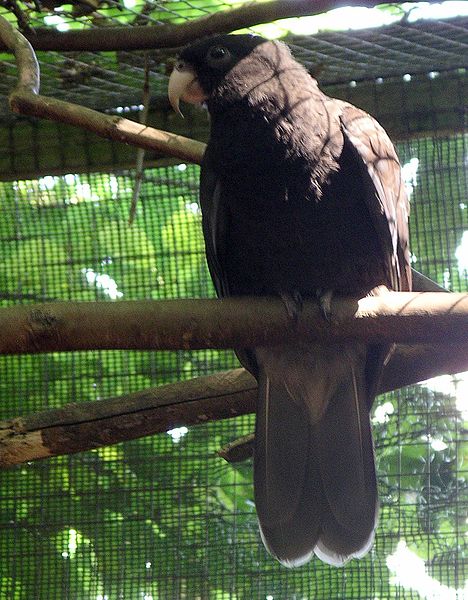
Natural History
Vasa Parrots are limited in distribution to Madagascar and the nearby Comoro Islands. They were introduced to Reunion Island but appear not to have become established.
They favor forest edges but forage in savanna and other open habitats; in some areas they raid corn crops and are hunted for that reason. Flocks of up to 200 have been reported in the past, but populations are now likely declining due to severe habitat loss.
Vasa Parrots reportedly move about on moonlit nights and often feed in the company of starlings, bulbuls and other species.
The closely related Lesser Vasa or Black Parrot, Coracopis nigra, (please see photo) is less common and not well-established in captivity.
Unique Color-Changing Abilities
The Vasa Parrot is distinguished from most other parrots by its brownish-black plumage, broad, heavy bill and long legs and neck. At breeding time, however, females pull off a stunt that is unequalled in the parrot world – some of their feathers change color (to brown) without going through a molt! This phenomenon is believed to hinge upon changes in the distribution of melanin, but has not been well-studied.
In addition, they shed the feathers at the top of their heads, and the underlying skin becomes yellow. The males’ skin darkens to almost black, and they sprout an orange or yellow wattle below the lower bill.
Unusual Reproductive Strategies
Vasa Parrots are also rule-breakers when it comes to reproduction. While similarly-sized parrots incubate their eggs for an average of 30 days, those of the Vasa hatch in approximately half that time – 14 to17 days. The chicks feed ravenously and fledge in a mere 45 days or so, again in about half the time usually taken by other parrots.
Female Vasa Parrots are, in general, the more aggressive sex, usually fight if housed together at breeding time; there are reports of females killing their mates as well. Wild females mate with up to 5 males, all of which then provide food while the females are incubating. Males may mate with several females as well.
Females defend the area around the nest-hole and call loudly (males do not); those with the strongest calls attract the most males. It is theorized that their brightly-colored, featherless heads act as a mate attractant as well.
Vasa Parrots as Pets
Vasa Parrots are being bred in captivity but, perhaps due to their plain plumage, are not very popular. They are, however, highly recommended by most owners and form strong bonds with people if handled properly.
Vasas are extremely active and inquisitive and are harder on toys, perches and cage bars than most other medium-sized parrots. They must be kept busy if they are to thrive, and fare best in outdoor aviaries and large cages. Most individuals are rather quiet by parrot standards.
Further Reading
Vasa Parrot reproduction is even odder than described above! Please see this Ibis article for details.
Video of a playful Vasa Parrot.
Vasa Parrot image referenced from wikipedia and originally posted by Snowmanradio
 That Bird Blog – Bird Care and History for Pet Birds
That Bird Blog – Bird Care and History for Pet Birds



